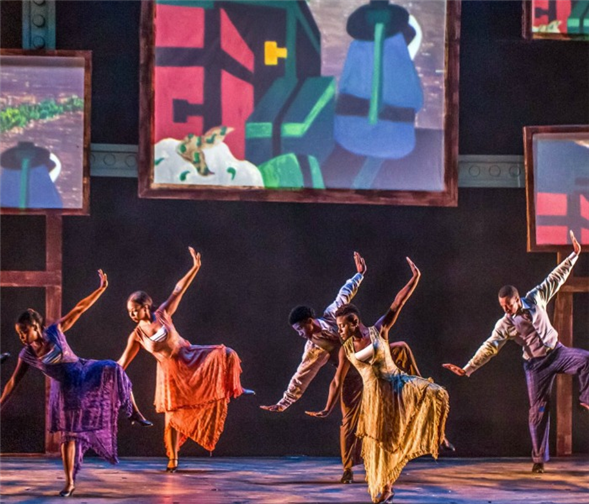Translate Page

Step Afrika! brings Jacob Lawrence's Migration Series to the stage
---
In 1941 at age of 23, artist Jacob Lawrence became a national sensation thanks to his Migration Series, 60 paintings depicting the mass exodus of African Americans from the South as they made their way North. Seven decades later, Washington, D.C.-based troupe Step Afrika! created The Migration: Reflections on Jacob Lawrence, a performance that turns visual art into dance theatre. "The stage is our canvas, our bodies are the brush, and the movement is the paint," is how Jakari Sherman, the director of the show as well as one of its 12 choreographers and 14 performers, describes the process.
Playing through Thanksgiving weekend at the New Victory Theater, The Migration is not, as you might imagine, a literal adaptation. "We took the Jacob Lawrence paintings as inspiration, and went beyond them," says C. Brian Williams, who founded Step Afrika! in 1994 to promote stepping, an African-American form of dance that uses stomping, clapping, and chanting to produce a rhythmic soundscape. "The Migration is a percussive tribute to our ancestors."
Lawrence's series focuses primarily on the period between World Wars I and II, when 1.6 million African Americans moved from the mostly rural South to northern industrial cities like Chicago, New York, and St. Louis. However, Step Afrika!'s show begins hundreds of years earlier, in a West African village in the 17th century, and ends in Chicago in the 1930s. It's comprised of six dance pieces, some pulled from Step Afrika!'s preexisting repertoire, that progress chronologically as five screens project a rotating selection of Lawrence's paintings.
The Migration begins with the performers, dressed in traditional African fabric and gold, beating on drums. Eventually they begin to sway. "Their movement mimics the waves of the ocean which they are forced to cross," Sherman explains. Meanwhile, the screens only display close-up details from Lawrence's panels so it's hard to make much out. "We start off very abstract, just presenting Lawrence's color scheme," Sherman explains. "We're using his palette, his texture."
The first words are not spoken until a half hour into the 80-minute show -- "They took the drums away" -- an allusion to the Negro Act of 1740 in South Carolina, which, among other heinous restrictions, prohibited the "using or keeping of drums, horns, or other loud instruments, which may call together or give sign or notice to one another of their wicked designs and purposes." Performers use a rhythm stick and their bodies to substitute for the drums -- the beginning of a tradition that eventually led to tap dancing and stepping.
Later in the piece, Lawrence's work comes into fuller focus. In one sequence, the screens simultaneously display one of his most powerful panels: a figure in red hunched over in grief beneath a tree branch fitted with a noose -- the aftermath of a lynching. On the stage, a complementary scene plays out: A man in rags stands to the side in harsh lighting as a woman in church dances in pain and sorrow, Bible in hand, while a spiritual is sung.
After intermission, Lawrence's train-themed paintings signify the migration of African Americans northward. The performers, dressed in their finest early 20th-century traveling clothes, use their bodies to imitate both the motions and sounds of a locomotive.
The final scene takes place in Chicago beneath projections of paintings of the city's train station, apartment buildings, and a steel plant. Tap dancing, stepping, and modern dance merge in an exuberant celebration of urban life.
Theatregoers eager to see more of Lawrence's work don't have to go far: Right underneath the New Victory Theater in the Times Square subway station is his glass mosaic: "New York in Transit."
---
TDF MEMBERS: Go here to browse our latest discounts for dance, theatre, and concerts.
Jonathan Mandell is a drama critic and journalist based in New York. Visit his blog at NewYorkTheater.me or follow him on Twitter at @NewYorkTheater. Follow TDF at @TDFNYC.
Top photo of Step Afrika!'s The Migration by William Perrigen.